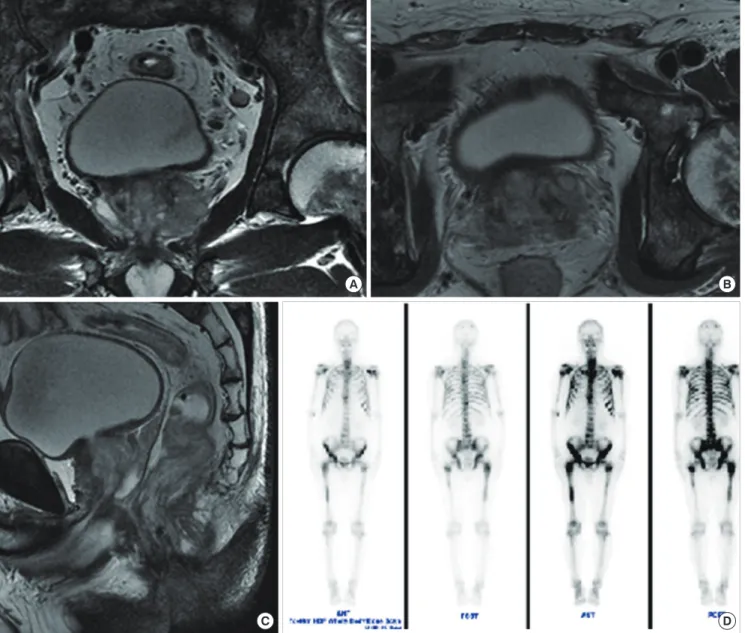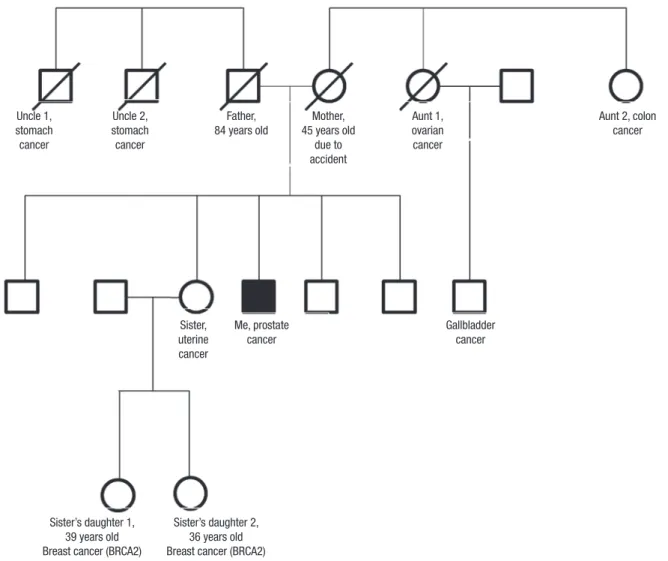Mutation: a Case Report and Literature Review
One of the most significant risk factors for prostate cancer (PC) is a family history of the disease, with germ-line mutations in the breast cancer predisposition gene (BRCA) 2 conferring the highest risk. We here report a 56-year-old man presented with painful gait disturbance and diagnosed PC with multiple disseminated bone metastases. The patient had a strong family history of breast cancer with his 2 nieces affected. Furthermore, his aunts and uncles from both sides were diagnosed with stomach, ovarian, and colorectal cancers. His genomic sequencing analysis of the BRCA genes revealed the same BRCA2 deleterious mutation that his breast cancer-affected nieces carried. Previous studies have suggested that BRCA2-mutated PC is associated with a more aggressive phenotype and poor prognosis. Our experience in the present case also indicated the urgent needs for novel treatment modality and PC screening in this high-risk group of patients.
Keywords: Prostate Cancer; BRCA; Genetic Mutation; Family History Won Hoon Song,1* Sung Han Kim,2*
Jae Young Joung,2 Weon Seo Park,2,3 Ho Kyung Seo,2 Jinsoo Chung,2 and Kang Hyun Lee2
1Department of Urology, Seoul National University Hospital, Seoul, Korea; 2Department of Urology, Center for Prostate Cancer, National Cancer Center, Goyang, Korea; 3Department of Pathology, Center for Prostate Cancer, National Cancer Center, Goyang, Korea
* Won Hoon Song and Sung Han Kim contributed equally to this work.
Received: 8 September 2015 Accepted: 1 February 2016 Address for Correspondence:
Kang Hyun Lee, MD
Department of Urology and Center for Prostate Cancer, Research Institute and Hospital of National Cancer Center, 323 Ilsan-ro, Ilsandong-gu, Goyang 10408, Republic of Korea
E-mail: uroonco@ncc.re.kr
Funding: This study was supported by the Korean National Cancer Center Grants (No. 1510170).
INTRODUCTION
One of the most significant risk factors for prostate cancer (PC) is a family history of the disease. To date, germ-line mutations in the breast cancer predisposition gene (BRCA) 2 are the ge- netic events that have been shown to confer the highest risk of PC at 8.6-fold in men ≤ 65 years of age (1). Although it remains unclear how BRCA2 affect prostate tumorigenesis, deleterious mutations in BRCA2 genes have been associated with a more aggressive disease and poor clinical outcomes. Furthermore, the increasing incidence of PC worldwide emphasizes the ur- gent need for new methods of outcome prediction and patient stratification, particularly to identify those with potentially le- thal forms of the disease. We herein present a case of BRCA2- mutated PC with a family history of breast cancer. In addition, we reviewed the literature on germ-line mutations of the BRCA genes and their predictive values of patient outcomes.
CASE DESCRIPTION
A 56-year-old patient presented with gait disturbance due to pain in the right leg in September 2015. His prostate-specific
antigen (PSA) level was 3,566 ng/mL, and he was diagnosed with PC with multiple disseminated bone metastases in the whole axial and proximal appendicular skeleton (Fig. 1). The Gleason score on diagnosis was 9 (4 + 5) (Fig. 2). The digital rec- tal examination revealed a hard tender prostate estimated to weigh 40 g with left-sided extraprostatic extension but no rectal invasion. He was treated with hormonal therapy, including 50 mg nonsteroidal antiandrogen therapy once daily combined with an 11.25 mg injection of a gonadotropin-releasing hormone (GnRH) agonist. After 2 months of therapy, his bone pain sub- sided, and his PSA level decreased to 740 ng/mL. His family ped- igree revealed a strong history of breast cancer with his 2 nieces being diagnosed at the age of 36 and 39 years (Fig. 2). Further- more, he had 2 aunts and 2 uncles from both sides who had been diagnosed with stomach cancer, ovarian cancer, or colorectal cancer. His genomic sequencing analysis of the BRCA genes re- vealed the same BRCA2 NM_000059.3:c.3744_3747delTGAG (p.Ser1248Argfs*10) mutation that his breast cancer-affected nieces carried (Fig. 3). Further PC surveillance, including digital rectal examination and PSA screening, was planned for the pa- tient’s male relatives.
Ethics statement
Informed written consent was submitted by the patient and the review was exempted by the Institutional Review Board of the National Cancer Center (August 25, 2015).
DISCUSSION
The role of BRCA germ-line mutations in male cancer has been extensively studied although they are present in only 1%–2% of sporadic PC cases (1). Previous studies have estimated the rela- tive risk for developing PC in men from the families with a patho- genic BRCA2 mutation to be 2.9–4.8 with an approximate 20%
lifetime risk and a relative risk as high as 7.3 in some subgroups
such as those < 65 years old (1).
BRCA2 is a tumor suppressor gene inherited in an autosomal dominant fashion with incomplete penetrance (2). Its function seems to be limited to DNA recombination and repair process- es, whereas a loss of function is associated with deficiency in repairing DNA double-strand breaks. Such a genomic instabili- ty might be the underlying cause of cancer predisposition re- sulted from deleterious mutations in the BRCA genes. Although the precise biology of BRCA2-associated aggressive PC pheno- type remains to be determined, it has been suggested that in PC cells, BRCA2 downregulation by small interfering RNAs might promote cancer cell migration and invasion, possibly via the upregulation of matrix metalloproteinase (3).
Fig. 1. Preoperative prostate MRI and bone scan images. (A) Sagittal view; (B) horizontal view; (C) axial view of MRI of the prostate showing left side-dominant PC with extra- capsular extension, seminal vesicle invasion, and enlarged left external and internal iliac lymph nodes; and (D) Disseminated bone metastasis in the whole axial and proximal appendicular bones.
MRI = magnetic resonance imaging, PC = prostate cancer.
A B
C D
In addition to a more aggressive tumor phenotype and more advanced tumor stage (T3–4), prostate tumors from BRCA2 mu- tation carriers are usually more poorly differentiated. These pa- tients often have a shorter median cancer-specific and overall survival than non-carriers receiving similar local treatment with curative intent (4). However, even the non-carriers have a poor- er outcome than others with sporadic PC, suggesting that a fam- ily history of breast cancer might also affect the prognosis of PC patients. These findings strongly support the contribution of other undetermined genetic factors to PC etiology and progno- sis in breast cancer-prone families (5,6), and suggest that the family members who do not carry the deleterious BRCA family- specific mutation might inherit other underlying genetic insta- bilities that increase their risk of cancer. A recent study by Dite et al. (7) indicated that first-degree relatives of women diagnosed with breast cancer at a young age (≤ 35 years) had an increased risk of developing a variety of cancers, irrespective of mutation status, and that some other underlying familial factors in these families, such as variants in other genes, might predispose indi- viduals to cancer.
Currently, there is no consensus on the most appropriate treat- ment for localized PC in BRCA mutation carriers, and more clin- ical evidence is still needed. Nonetheless, radical treatment with either surgery or radiotherapy is preferable to active surveillance, even for low-risk cases. Previous studies have also supported adjuvant treatment in BRCA mutation carriers as they often ex- perience early nodal spread and more frequent metastasis (4).
One of the most important clinical issues in the treatment of
BRCA-related tumors is the choice of chemotherapy in both adjuvant and palliative settings. Platinum, taxanes, and more recently, poly (ADP-ribose) polymerase (PARP) inhibitors have been demonstrated to be active in breast and ovarian tumors harboring germ-line mutations of the BRCA genes, although its roles in PC would need further investigation (4,8,9). However, in clinical practice, it is questionable whether screening for BRCA mutations is necessary because their prevalence is low, and BR CA-positive PC patients with metastatic disease have been reported to respond to the standard chemotherapy regimen of docetaxel plus prednisolone similarly to those with wild-type BRCA (10). Additional considerations for deciding whether to undergo further treatment for metastatic PC include health in- surance coverage; it is uncertain if a PARP inhibitor for treatment of PC would be covered by insurance plans because the role of PARP inhibitors in PC has not yet been clarified.
While PC screening in men might be controversial (4), these findings suggested that genetically targeted testing of pre-symp- tomatic men with a higher risk of aggressive and fatal PC like those from families with BRCA2 mutation carriers might be clin- ically justified (5-7). Early diagnosis might be crucial in these patients, and a careful discussion about PC screening with an experienced urologist should be encouraged to inform both BRCA2 mutation carriers and non-carriers alike that due to their underlying genetic changes, they might be at an increased risk of developing clinically significant PC that could be difficult to manage and have a poor clinical outcome.
Fig. 2. Representative microphotographs of the prostate tumor. (A) Characteristic features of Gleason patterns 4 and 5, including fused glands and an almost complete loss of glandular lumina (H & E staining, [×100]). (B) Immunohistochemical staining of BRCA2 (×200).
BRCA2 = breast cancer predisposition gene 2, H & E = hematoxylin and eosin.
A B
Fig. 3. Pedigree. The patient’s mother died from a car accident at 45 years of age. His first aunt died from ovarian cancer, and her son from biliary cancer. His second aunt died from colorectal cancer. The 2 daughters of his elder sister were diagnosed with breast cancer at 39 and 36 years of age, and their gene sequencing analyses revealed that both had BRCA2 mutation NM_000059.3:c.3744_3747delTGAG (p.Ser1248Argfs*10).
BRCA2 = breast cancer predisposition gene 2.
Uncle 1, stomach cancer
Sister, uterine cancer
Me, prostate cancer
Gallbladder cancer
Sister’s daughter 1, 39 years old Breast cancer (BRCA2)
Sister’s daughter 2, 36 years old Breast cancer (BRCA2) Uncle 2,
stomach cancer
Father, 84 years old
Mother, 45 years old
due to accident
Aunt 1, ovarian cancer
Aunt 2, colon cancer
DISCLOSURE
The authors have no potential conflicts of interest to disclose.
AUTHOR CONTRIBUTION
Conceptualization: Kim SH, Joung JY, Lee KH. Data curation:
Song WH, Kim SH, Park WS. Investigation: Song WH, Kim SH, Park WS. Writing - review & editing: Joung JY, Park WS, Seo HK, Chung J, Lee KH.
ORCID
Won Hoon Song http://orcid.org/0000-0003-1930-6045 Sung Han Kim http://orcid.org/0000-0002-1689-5203 Jae Young Joung http://orcid.org/0000-0003-2954-1663 Weon Seo Park http://orcid.org/0000-0002-0035-1455
Ho Kyung Seo http://orcid.org/0000-0003-2601-1093 Jinsoo Chung http://orcid.org/0000-0003-2251-5331 Kang Hyun Lee http://orcid.org/0000-0003-0041-2243
REFERENCES
1. Breast Cancer Linkage Consortium. Cancer risks in BRCA2 mutation car- riers. J Natl Cancer Inst 1999; 91: 1310-6.
2. Venkitaraman AR. Cancer susceptibility and the functions of BRCA1 and BRCA2. Cell 2002; 108: 171-82.
3. Moro L, Arbini AA, Marra E, Greco M. Mitochondrial DNA depletion re- duces PARP-1 levels and promotes progression of the neoplastic pheno- type in prostate carcinoma. Cell Oncol 2008; 30: 307-22.
4. Castro E, Eeles R. The role of BRCA1 and BRCA2 in prostate cancer. Asian J Androl 2012; 14: 409-14.
5. Eeles RA, Kote-Jarai Z, Al Olama AA, Giles GG, Guy M, Severi G, Muir K, Hopper JL, Henderson BE, Haiman CA, et al. Identification of seven new prostate cancer susceptibility loci through a genome-wide association
relatives of very early-onset breast cancer cases with and without BRCA1 and BRCA2 mutations. Br J Cancer 2010; 103: 1103-8.
8. Audeh MW, Carmichael J, Penson RT, Friedlander M, Powell B, Bell-Mc- Guinn KM, Scott C, Weitzel JN, Oaknin A, Loman N, et al. Oral poly (ADP- ribose) polymerase inhibitor olaparib in patients with BRCA1 or BRCA2 mutations and recurrent ovarian cancer: a proof-of-concept trial. Lancet
376: 235-44.
10. Gallagher DJ, Cronin AM, Milowsky MI, Morris MJ, Bhatia J, Scardino PT, Eastham JA, Offit K, Robson ME. Germline BRCA mutation does not pre- vent response to taxane-based therapy for the treatment of castration-re- sistant prostate cancer. BJU Int 2012; 109: 713-9.

![Fig. 2. Representative microphotographs of the prostate tumor. (A) Characteristic features of Gleason patterns 4 and 5, including fused glands and an almost complete loss of glandular lumina (H & E staining, [×100])](https://thumb-ap.123doks.com/thumbv2/123dokinfo/5140798.93787/3.892.76.824.106.477/representative-microphotographs-prostate-characteristic-features-gleason-including-glandular.webp)
